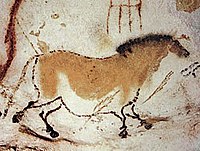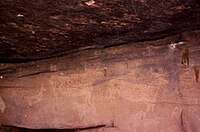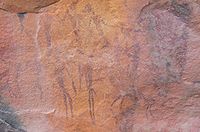This is an old revision of this page, as edited by Alfred Legrand (talk | contribs) at 07:55, 12 October 2007 (→References: 3/). The present address (URL) is a permanent link to this revision, which may differ significantly from the current revision.
Revision as of 07:55, 12 October 2007 by Alfred Legrand (talk | contribs) (→References: 3/)(diff) ← Previous revision | Latest revision (diff) | Newer revision → (diff){Cave or Rock Paintings are paintings on cave or rock walls and ceilings, usually dating to prehistoric times. The earliest known rock paintings are dated to the Upper Paleolithic, 40,000 years ago, while the earliest European cave paintings date to 32,000 years ago. The purpose of the cave paintings is not known, and may never be. The evidence suggests that they weren't merely decorations of living areas, since the caves in which they've been found don't have signs of ongoing habitation. Also, they are often in areas of caves that aren't easily accessed. Some theories hold that they may have been a way of transmitting information, while other theories ascribe them a religious or ceremonial purpose.
Europe

When Marcelino Sanz de Sautuola first encountered the Magdalenian paintings of the Altamira cave, Cantabria, Spain in 1879, the academics of the time considered them hoaxes. Recent reappraisals and increasing numbers of discoveries have illustrated their authenticity and have indicated high levels of artistry of Upper Palaeolithic humans who used only basic tools. Cave paintings can also give valuable clues as to the culture and beliefs of that era.
Locations
Well known cave paintings include those of:
- Lascaux, France
- La Marche, near Lussac-les-Chateaux, France
- Chauvet Cave, near Vallon-Pont-d'Arc, France
- Altamira, near Santillana del Mar, Cantabria, Spain
- Cosquer Cave, with an entrance below sea level near Marseille, France
- Font de Gaume, in the Dordogne Valley in France
Other sites include Creswell Crags, Nottinghamshire, England. (Cave etchings and bas-reliefs discovered in 2003), and Magura , Belogradchik, Bulgaria.
Rock painting was also performed on cliff faces, but fewer of those have survived because of erosion. One well-known example is the rock paintings of Astuvansalmi in the Saimaa area of Finland.
Age
Nearly 350 caves have now been discovered in France and Spain that contain art from prehistoric times. The age of the paintings in many sites has been a contentious issue, since methods like radiocarbon dating can be easily misled by contaminated samples of older or newer material, and caves and rocky overhangs (parietal art) are typically littered with debris from many time periods. Recent advances make it possible to date the paintings by sampling the pigment itself.
The choice of subject matter can also indicate date such as the reindeer at the Spanish cave of Cueva de las Monedas which imply the art is from the last Ice Age. The oldest cave is that of Chauvet, and is 32,000 years old. Other examples may date as late as the Early Bronze Age, but the well known prolific and sophisticated style from Lascaux and Altamira died out about 10,000 years ago, coinciding with the advent of the neolithic period.

Themes and patterns
The most common themes in cave paintings are large wild animals, such as bison, horses, aurochs, and deer, and tracings of human hands as well as abstract patterns, called finger flutings. Drawings of humans are rare and are usually schematic rather than the more naturalistic animal subjects. Cave art may have begun in the Aurignacian period (Hohle Fels, Germany), but reached its apogee in the late Magdalenian (Lascaux, France).
The paintings were drawn with red and yellow ochre, hematite, manganese oxide and charcoal. Sometimes the silhouette of the animal was incised in the rock first.
Theories and interpretations
Henri Breuil interpreted the paintings as being hunting magic, meant to increase the number of animals. As there are some clay sculptures that seem to have been the targets of spears, this may partly be true, but does not explain the pictures of predators such as the lion or the bear.
An alternative theory, developed by David Lewis-Williams and broadly based on ethnographic studies of contemporary hunter-gatherer societies, is that the paintings were made by Cro-Magnon shamans. The shaman would retreat into the darkness of the caves, enter into a trance state and then paint images of their visions, perhaps with some notion of drawing power out of the cave walls themselves. This goes some way toward explaining the remoteness of some of the paintings (which often occur in deep or small caves) and the variety of subject matter (from prey animals to predators and human hand-prints).
R. Dale Guthrie has studied not only the most artistic and publicized paintings but also a variety of lower quality art and figurines, and he identifies a wide range of skill and ages among the artists. He also points that the main themes in the paintings and other artifacts (powerful beasts, risky hunting scenes and the over-sexual representation of women in the Venus figurines) are to be expected in the fantasies of adolescent males, who made a big part of the human population at the time. According to Merlin Stone in her book When God Was a Woman, many scholars and archaeologists impose modern sexist views on ancient findings. Considering the prevalence of Goddess worship (beginning between 7,000 and 25,000 B.C.E), it is much more probable that art depicting the fullness of a woman's body was not a teenage male's fantasy but reproductions done in praise of women by artists of either sex. As with all prehistory, it is impossible to be certain because of the relative lack of material evidence and the many pitfalls associated with trying to understand the prehistoric mindset.
Graham Hancock's Supernatural: Meetings with the Ancient Teachers of Mankind explores the various theories on the interpretation of rock art, and provides extensive references. He concludes that recent theory linking shamanic and religious practices with cave painting throughout the world appear the most credible.
Africa

At Ukhahlamba-Drakensberg, South Africa, now thought to be some 3,000 years old, the paintings by the San people who settled in the area some 8,000 years ago depict animals and humans, and are thought to represent religious beliefs.
Recently, an archeological team discovered the Laas Gaa'l cave paintings outside Hargeisa in Somaliland. They show the ancient inhabitants of the area worshipping cattle and performing religious ceremonies.
Cave paintings are found in the Tassili n'Ajjer mountains in southeast Algeria also in the Akakus, Messak Settafet and Tadrart in Libya and other Sahara regions including: Ayr mountains, Niger and Tibesti, Chad.
Mexico
The Rock Paintings of Sierra de San Francisco is the name given to prehistoric rock art found in the Sierra de San francisco region of Baja California, Mexico, created by a people referred to as Cochimi or Guachimis. There are some 250 sites which are located in the municipality of Mulege within the El Vizcaino Biosphere Reserve in the state of Baja California Sur in Northern Mexico. Motifs include human figures, weapons, and animal species such as rabbit, puma, lynx, deer, wild goat/sheep, whale, turtle, tuna, sardine, octopus, eagle, and pelican; there are also abstract elements of various forms. The paintings vary in age from 1100 BC to AD 1300.
The paintings are noted for their high quality, extent, the variety and originality of human and animal representations, remarkable colors, and excellent state of preservation. The rock paintings of Sierra de San Francisco were nominated in 1989 and became a World Heritage Site in 1993.
Australia
Significant early cave paintings have also been found in Kakadu National Park in Australia.
The park has a large collection of ochre paintings. Ochre is a not an organic material, so carbon dating of these pictures is impossible. Sometimes the approximate date, or at least, an epoch, can be guessed from the content.
-
 A male hunter or warrior.
A male hunter or warrior.
-
 A wallaby (and some other things).
A wallaby (and some other things).
-
 An elaborate turtle.
An elaborate turtle.
- Fishes -- an X-ray style painting -- with some internal organs shown in detail. Fishes -- an X-ray style painting -- with some internal organs shown in detail.
- A macropod's (probably kangaroo's) skeleton (?) A macropod's (probably kangaroo's) skeleton (?)
Southeast Asia

There are rock paintings in caves in India, Thailand, Malaysia and Indonesia. In Thailand, caves and scarps along the Thai-Burmese border, in the Petchabun Range of Central Thailand, and overlooking the Mekong River in Nakorn Sawan Province, all contain galleries of rock paintings. In Malaysia the oldest paintings are at Gua Tambun in Perak, dated at 2000 years, and those in the Painted Cave at Niah Caves National Park are 1200 years old. See prehistoric Malaysia. In Indonesia the caves at Maros in Sulawesi are famous for their hand prints, also found in caves in the Sangkulirang area of Kalimantan.
More information
DAMASCUS (Reuters) - French archaeologists have discovered an 11,000-year-old wall painting underground in northern Syria which they believe is the oldest in the world Reference: Khaled Yacoub Oweis Thu Oct 11, 12:05 PM ET
The 2 square-meter painting, in red, black and white, was found at the Neolithic settlement of Djade al-Mughara on the Euphrates, northeast of the city of Aleppo, team leader Eric Coqueugniot told Reuters.
"It looks like a modernist painting. Some of those who saw it have likened it to work by (Paul) Klee. Through carbon dating we established it is from around 9,000 B.C.," Coqueugniot said.
"We found another painting next to it, but that won't be excavated until next year. It is slow work," said Coqueugniot, who works at France's National Centre for Scientific Research.
Rectangles dominate the ancient painting, which formed part of an adobe circular wall of a large house with a wooden roof. The site has been excavated since the early 1990s.
The painting will be moved to Aleppo's museum next year, Coqueugniot said. Its red came from burnt hematite rock, crushed limestone formed the white and charcoal provided the black.
The world's oldest painting on a constructed wall was one found in Turkey but that was dated 1,500 years after the one at Djade al-Mughara, according to Science magazine.
The inhabitants of Djade al-Mughara lived off hunting and wild plants. They resembled modern day humans in looks but were not farmers or domesticated, Coqueugniot said.
"There was a purpose in having the painting in what looked like a communal house, but we don't know it. The village was later abandoned and the house stuffed with mud," he said.
A large number of flints and weapons have been found at the site as well as human skeletons buried under houses.
"This site is one of several Neolithic villages in modern day Syria and southern Turkey. They seem to have communicated with each other and had peaceful exchanges," Coqueugniot said.
Mustafa Ali, a leading Syrian artist, said similar geometric design to that in the Djade al-Mughara painting found its way into art throughout the Levant and Persia, and can even be seen in carpets and kilims (rugs).
"We must not lose sight that the painting is archaeological, but in a way it's also modern," he said.
France is an important contributor to excavation efforts in Syria, where 120 teams are at work. Syria was at the crossroads of the ancient world and has thousands of mostly unexcavated archaeological sites.
Swiss-German artist Paul Klee had links with the Bauhaus school and was important in the German modernist movement.
See also
References
- R. Dale Guthrie, The Nature of Paleolithic Art. University Of Chicago Press, 2006. ISBN 978-0-226-31126-5. Preface.
- "Rock Shelters of Bhimbetka". World Heritage Site. Retrieved 2007-02-15.
3. Khaled Yacoub Oweis Thu Oct 11, 12:05 PM ET
Further reading
- Thomas Heyd and John Clegg, eds. Aesthetics and Rock Art. Ashgate Publishing, Aldershot, England and Burlington, VT, USA. 2005. ISBN 0-7546-3924-X
- Gregory Curtis, The Cave Painters: Probing the Mysteries of the World's First Artists, Knopf, New York, NY, USA, 2006. 1-4000-4348-4
External links
- Bradshaw Foundation The recording of cave paintings around the world
- EuroPreArt database of European Prehistoric Art
- Malaysian Caves
- Cave paintings in Castell de Castells Spain
- American Rock Art Research Association